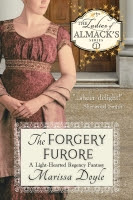 If ever there was a princess in need of a handsome prince, it was Charlotte Augusta, Princess of Wales. The only daughter of Prince George and Princess Caroline, she had her father’s florid looks and her mother’s earthy temperament. She laughed too loudly, threw temper tantrums at will, and never learned the fine art of diplomacy expected of a princess and heir to the throne.
If ever there was a princess in need of a handsome prince, it was Charlotte Augusta, Princess of Wales. The only daughter of Prince George and Princess Caroline, she had her father’s florid looks and her mother’s earthy temperament. She laughed too loudly, threw temper tantrums at will, and never learned the fine art of diplomacy expected of a princess and heir to the throne.  On the other hand, His Serene Highness Leopold George Christian Frederick, Prince of Saxe-Coburg, was apparently aptly named. With no money behind his fancy name and no particularly impressive connections among his bloodline, the twenty-six-year-old youngest son of a minor house needed to be a diplomat. He had served well in the war against Napoleon and cut a rather dashing figure.
On the other hand, His Serene Highness Leopold George Christian Frederick, Prince of Saxe-Coburg, was apparently aptly named. With no money behind his fancy name and no particularly impressive connections among his bloodline, the twenty-six-year-old youngest son of a minor house needed to be a diplomat. He had served well in the war against Napoleon and cut a rather dashing figure.  Though the Prince Regent urged his daughter to marry the Prince of Orange, Charlotte was captivated by Leopold and begged her father incessantly to allow her to marry him. She is said to have written in her diary “I find him charming . . . I am certainly a very fortunate creature and have to bless God. A Princess never, I believe, set out in life with such prospects of happiness, real domestic ones like other people.”
Though the Prince Regent urged his daughter to marry the Prince of Orange, Charlotte was captivated by Leopold and begged her father incessantly to allow her to marry him. She is said to have written in her diary “I find him charming . . . I am certainly a very fortunate creature and have to bless God. A Princess never, I believe, set out in life with such prospects of happiness, real domestic ones like other people.” Prinny reluctantly relented, and the engagement was announced on March 14, 1816. The Prince insisted on the couple remaining apart during the next few months, and they saw each other only occasionally. They were married at nine in the evening on May 2, 1816, at her father’s Carlton House in London in the Crimson State Room. Around fifty people attended, most members of the royal family or faithful retainers. The Prince Regent, Duke of York, Duke of Clarence, and many of the other gentlemen in attendance wore military uniforms, as did Prince Leopold, who was resplendent in the embroidered coat of a British General, a commission he had been granted, and white wool breeches.

Charlotte certainly looked the part of a princess. Her wedding gown, which cost over 10,000 pounds, was made from silver lamé over net, with a silver tissue slip. The hem and sleeves were embroidered with silver lame shells and flowers and trimmed with Brussels lace. She also wore a manteau of silver tissue lined with white satin, embroidered to match the dress and fastened with a single diamond. On her head was a tiara of brilliants formed into rosebuds and leaves.
One of the reports at the time claimed she “wore on her countenance that tranquil and chastened joy which a female so situated could not fail to experience.” That doesn’t sound a great deal like Charlotte. But even dressed like a princess, poor Charlotte couldn’t behave like one. Supposedly she giggled when her penniless groom promised to endow her with all his worldly goods.
Leopold did his best to guide his headstrong wife, and she did her best to heed his advice, after a decent tantrum or two, of course. Theirs was to be a model marriage, lauded by the common folk, appreciated by the aristocracy, until Charlotte’s untimely death in childbirth a year and a half later.





No comments:
Post a Comment